It’s not always easy to keep up with your dog’s health. One day they’re perfectly happy and healthy, and the next they’re scratching their belly like crazy and you realize they have a bunch of brown spots on their belly that look like dirt!
What are these spots, and what can you do about them? In this blog post, we will discuss the causes of brown spots on your dog’s belly that look like dirt, as well as some treatment options.
- Key Takeaway
- What Are Those Brown Spots On My Dogs Belly That Look Like Dirt?
- How Will The Vet Diagnose and Treat Brown Spots on Your Dog?
- Can New Brown Spots on a Dog’s Skin Be a Sign of Cancer?
- What Is Hyperpigmentation?
- Can A Dog Get Age Spots?
- How Do I Get Rid of Dark Spots on a Dog’s Belly?
- FAQ – Brown Spots on Dog’s Belly That Look Like Dirt
- Q: What are those brown spots on my dog’s belly that look like dirt?
- Q: Can hyperpigmentation in dogs be a sign of a more serious condition?
- Q: What causes brown spots on a dog’s belly?
- Q: Can flea bites cause brown spots on a dog’s belly?
- Q: Are age spots common in dogs?
- Q: How can I tell the difference between brown spots on my dog’s skin and dirt?
- Q: Can yeast infections cause brown spots on a dog’s belly?
- Q: What should I do if I notice dark spots on my dog’s belly?
- Q: Can skin cancers cause brown spots on a dog’s belly?
- Q: How can I prevent brown spots on my dog’s belly?
- In Conclusion
Brown spots on your dog’s belly that look like dirt can be caused by various factors, including irritation, infection, injury, hormonal changes, exposure to the sun, yeast infections, flea dirt, or even melanomas, and in some cases, it could be a symptom of hyperpigmentation or Acanthosis Nigricans.
What Are Brown Spots On My Dog Belly That Look Like Dirt?
Brown spots on your dog’s belly that look like dirt could be a sign of flea infestation, bacterial or yeast infections, pigmentary demodicosis, allergies, hyperpigmentation, aging, sun exposure, or even melanomas.
1. Pigmentary demodicosis
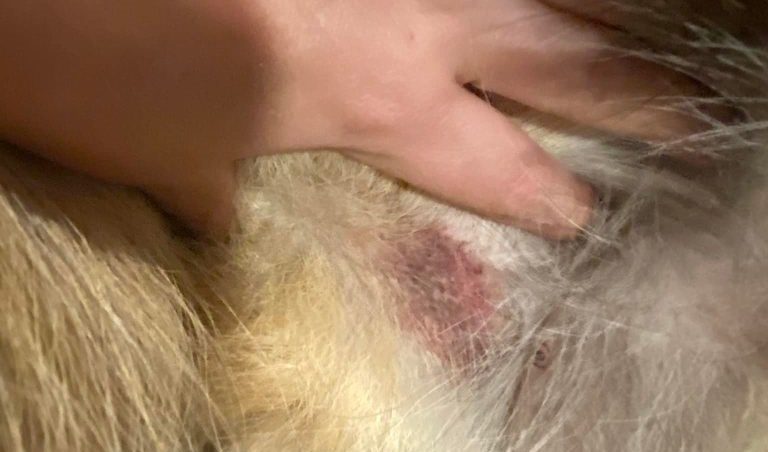
Pigmentary demodicosis can appear as brown spots on a dogs belly that look like dirt. In some cases, pigmentary demodicosis can also cause hair loss.
Pigmentary demodicosis is a medical condition that can affect dogs. It is caused by an overgrowth of the Demodex mite, which is a type of mite that naturally lives on the skin of dogs. The overgrowth of these mites can cause the dog’s skin to become irritated and inflamed.
It is important to understand that pigmentary demodicosis is not dangerous for dogs. From this medical condition, the dog’s skin can appear to have brown spots that look like dirt. Also, the dog might start to lose hair.
MedCave did a great study on pigmentary demodicosis in canines where 31% out of the dogs tested positive.
How to diagnose pigmentary demodicosis in dogs
- Physical Examination: The vet may start with a thorough physical examination of the dog. The condition usually presents as symmetrical hair loss starting on the trunk and spreading towards the tail and head.
- Skin Scrapings: This is done to look for the presence of Demodex mites. These mites are common in all dogs, but an overpopulation can cause skin problems. The scraping involves taking a sample from the dog’s skin using a scalpel blade and looking at it under a microscope.
- Biopsy: In some cases, a skin biopsy may be required to rule out other diseases. The biopsy involves removing a small piece of skin under local anesthesia to be examined under a microscope.
- Blood Tests: Blood tests can help rule out hormonal conditions like hypothyroidism or Cushing’s disease which can also cause hair loss.
Treating Pigmentary Demodicosis in Dogs
- Miticide Treatments: Medications such as ivermectin, milbemycin oxime, or moxidectin are often used to kill the Demodex mites causing the condition.
- Topical Treatments: Medicated shampoos or dips can help to reduce the number of mites on the dog’s skin and soothe inflammation.
- Antibiotics or Antifungal Medications: If a secondary infection has occurred due to the mites, antibiotics or antifungal medications may be necessary.
- Good Nutrition and Skin Care: A balanced diet, regular grooming, and good skin care can help improve the dog’s overall health and reduce the likelihood of a mite overpopulation.
2. Bacterial or fungal infection
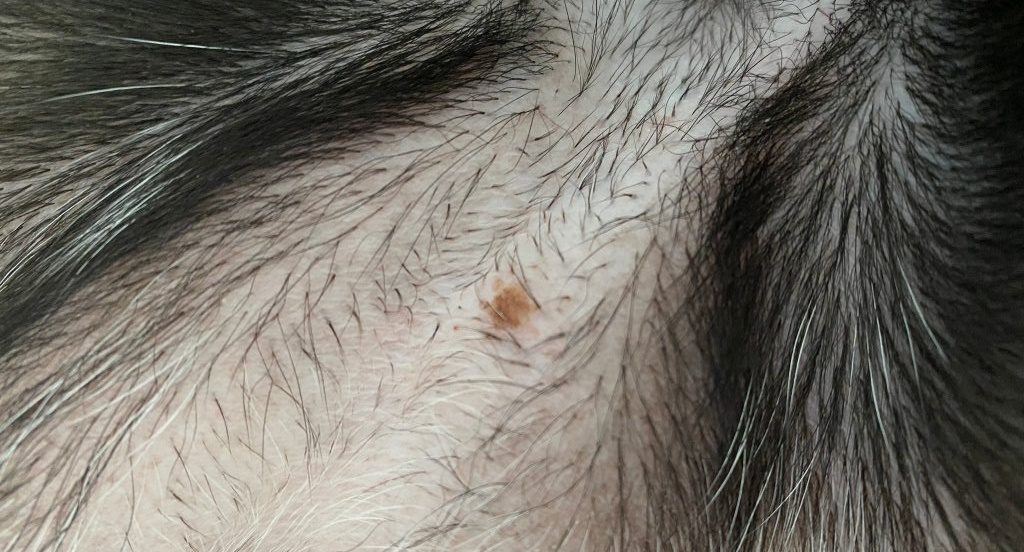
Bacterial or fungal infection in dogs is a condition in which the dog’s skin becomes irritated and inflamed.
A bacterial infection is caused by harmful bacteria that invade the dog’s body. These can be localized (like a wound infection) or systemic (affecting the entire body, such as a urinary tract infection).
Fungal infections result from the overgrowth of fungi, which are normally present in small amounts on a dog’s body. These can lead to conditions like ringworm or yeast infections on the skin or ears.
The most common symptom of bacterial or fungal infection in dogs is brown spots on the skin.
Other symptoms include:
- Itchiness
- Redness
- Scaling
If you notice any of these symptoms in your dog, it is important to take them to the vet for treatment.
Diagnosing Bacterial or Fungal Infections in Dogs
- Physical Examination: The vet will start by examining the dog’s overall health and inspecting the affected area. Symptoms such as redness, swelling, discharge, or unusual odors can indicate an infection.
- Microscopic Examination: If the infection is suspected to be on the skin or in the ears, the vet may take a sample of cells or discharge from the affected area for microscopic examination. This can help identify the type of bacteria or fungus involved.
- Culture and Sensitivity Test: This test involves growing the bacteria or fungus in a lab to confirm its identity and determine which antibiotics or antifungal medications it’s sensitive to.
- Blood Tests: If an internal infection is suspected, blood tests can help identify the presence of bacteria or fungi in the bloodstream.
Treating Bacterial or Fungal Infections in Dogs
- Antibiotics or Antifungal Medications: If a bacterial infection is confirmed, the vet will typically prescribe antibiotics. For a fungal infection, antifungal medications will be used. It’s important to complete the entire course of medication, even if the dog seems to be getting better.
- Topical Treatments: For skin or ear infections, topical creams, ointments, or ear drops may be prescribed in addition to or instead of oral medications.
- Medicated Baths: Medicated shampoos or rinses can help treat skin infections and soothe irritated skin.
- Surgery: In severe cases, or if an abscess has formed, surgery may be necessary to remove infected tissue.
3. Fleas
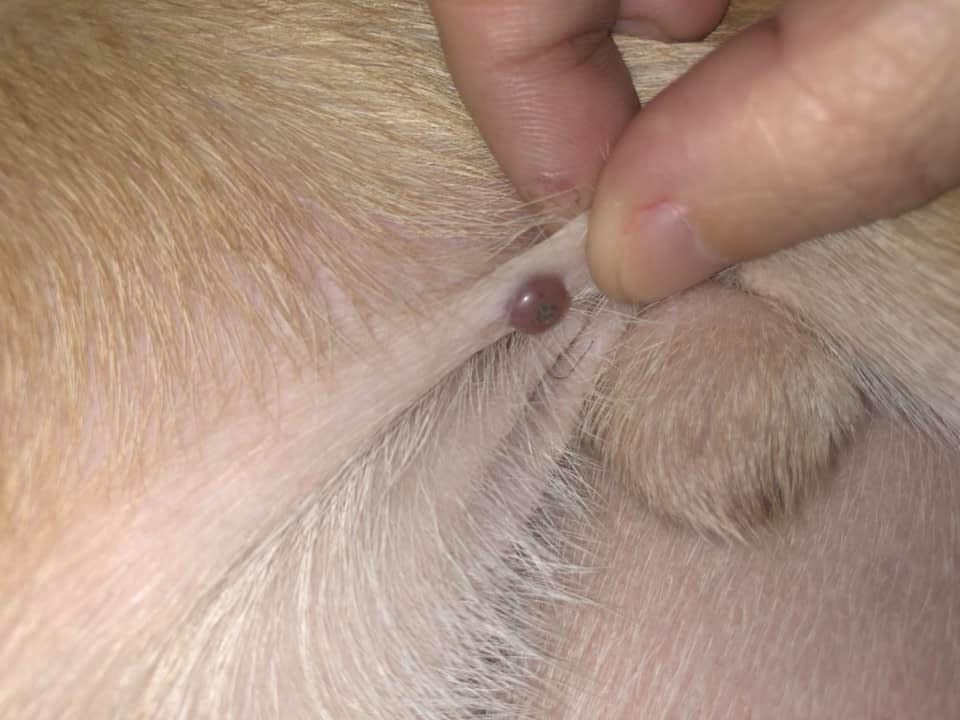
Fleas are small, brown insects that feed on the blood of animals. They’re a common problem for dogs and can cause irritation and skin problems.
Fleas can be difficult to spot on your dog’s fur, but you may notice them if your dog is scratching a lot or has bald spots.
Fleas are not only a nuisance for both dogs and their owners, but they can also transmit diseases and cause anemia.
Diagnosing Fleas in Dogs
- Visual Inspection: Fleas are tiny, but they can be seen moving on the dog’s skin. They are especially likely to gather around the dog’s neck, tail, and underbelly.
- Flea Dirt: This is flea feces, which looks like small black or brown specks on the dog’s skin or coat. If you find this, it’s a strong sign your dog has fleas even if you don’t see the fleas themselves.
- Excessive Scratching, Biting, or Licking: These are common symptoms of fleas. The dog may also show signs of restlessness due to the discomfort caused by the bites.
- Hair Loss or Skin Lesions: Some dogs may have an allergic reaction to flea saliva, leading to hair loss or skin sores.
- Vet Examination: If you’re unsure whether your dog has fleas, a vet can perform a thorough examination to confirm.
Treating Fleas in Dogs
- Flea Treatment Products: There are many effective products available to kill fleas on dogs, including topical treatments, oral medications, shampoos, and sprays. It’s important to choose a product suitable for your dog’s age and size.
- Environmental Treatment: Fleas can survive in the environment, so it’s essential to treat the areas where your dog spends time. This may include washing bedding and soft furnishings, vacuuming thoroughly, and using a household flea spray.
- Preventative Measures: Once the infestation is under control, use a regular preventative treatment to keep fleas at bay. This can be a monthly topical treatment or oral medication.
4. Aging
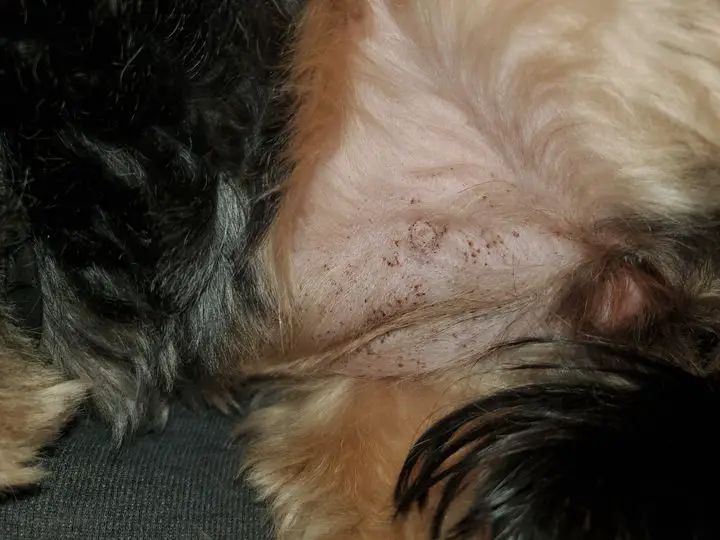
As a dog ages, its skin can become thin and dry, which may cause brown spots that look like dirt.
Also, age can cause a decrease in the production of melanin, which can lead to lighter-colored patches on a dog’s coat. If your dog has brown spots on its skin, consult your veterinarian to rule out any medical conditions that may be causing them.
Diagnosing Aging Spots in Dogs
- Visual Inspection: Aging spots are usually flat, round, and brown or black in color. They can appear anywhere on the dog’s body but are most commonly found on areas with thin fur, such as the belly.
- Physical Examination: A vet will perform a physical examination to rule out other conditions that may look similar to aging spots, like melanoma or other types of skin cancer.
- Biopsy: If there’s any doubt about the diagnosis, or if the spots are changing in size, shape, or color, a vet may perform a biopsy. This involves taking a small sample of the spot to examine under a microscope.
Treating Aging Spots in Dogs
- Monitor the Spots: Keep an eye on the spots for any changes in size, shape, or color. If you notice any changes, consult your vet immediately.
- Sun Protection: While aging spots aren’t caused by sun exposure, dogs with thin or light-colored fur can be more prone to sunburn. Use pet-safe sunscreen or provide shade to protect your dog from harmful UV rays.
- Regular Vet Check-ups: Regular check-ups can help detect any changes in your dog’s skin early. Your vet can monitor the aging spots and other aspects of your dog’s health as they age.
5. Melanomas
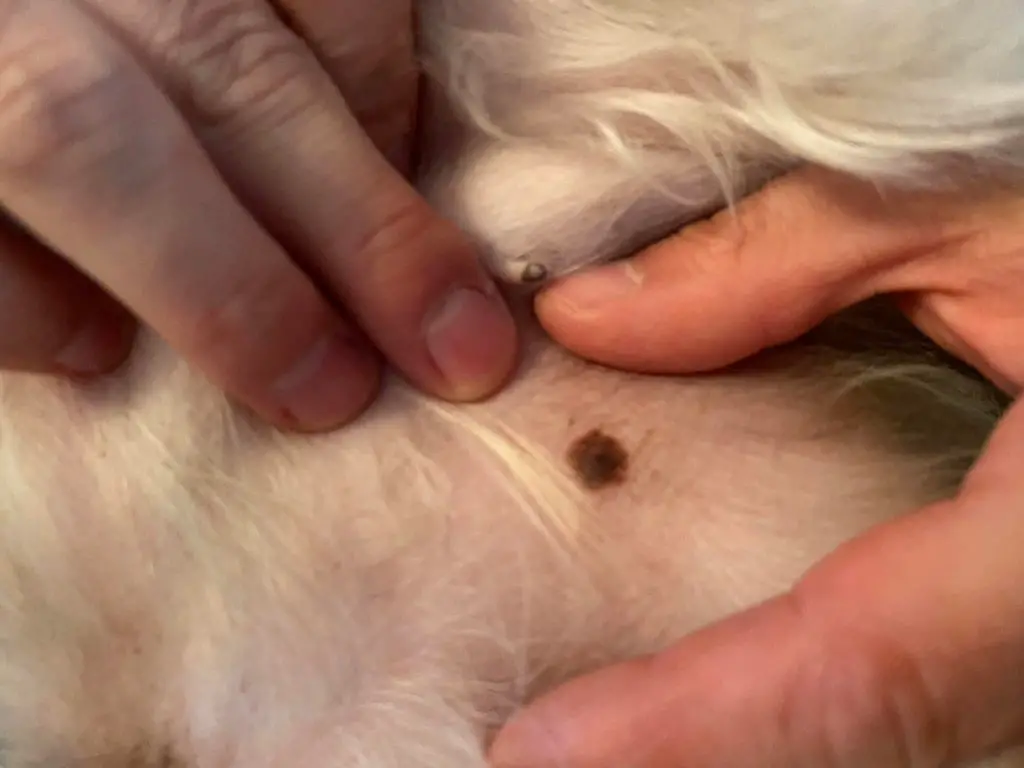
Melanomas are cancerous tumors that form in the cells that produce melanin. Melanin is the pigment that gives color to the skin and hair.
Dogs with black or dark-colored coats are more susceptible to developing melanomas. However, any dog can get this type of cancer.
The most common symptom of melanoma is:
- A change in the size
- Change in shape, or color of a mole or other dark spot on the skin
- Bleeding
- Crusting
- Ulceration
- Itching
There are many types of melanomas, but the most common type is black or brown says MVA.
Diagnosing Melanomas in Dogs
- Visual Inspection: Melanomas can appear as small, dark masses on the skin or mucous membranes. They may be raised, ulcerated, or change in size and color.
- Physical Examination: A vet will conduct a thorough physical examination to assess the dog’s overall health and to locate any tumors.
- Biopsy: This is the most definitive way to diagnose melanoma. The vet will take a tissue sample from the mass and examine it under a microscope.
- Imaging Tests: If the vet suspects the cancer has spread, they may recommend imaging tests like X-rays or ultrasound to check for metastasis.
Treating Melanomas in Dogs
- Surgery: If the tumor is in a location that allows for removal, surgery is often the first line of treatment. The goal is to remove the entire tumor along with a margin of healthy tissue.
- Radiation Therapy: This may be used if the tumor cannot be completely removed by surgery, or if the melanoma is located in a difficult-to-reach area.
- Chemotherapy: This is sometimes used in addition to surgery or radiation, especially if the cancer has spread to other parts of the body.
- Immunotherapy: Canine melanoma vaccine is an option for dogs with oral melanoma. It stimulates the dog’s immune system to fight the cancer cells.
- Palliative Care: If the melanoma is advanced and cannot be treated effectively, palliative care can help to manage symptoms and improve the dog’s quality of life.
6. Allergic reaction
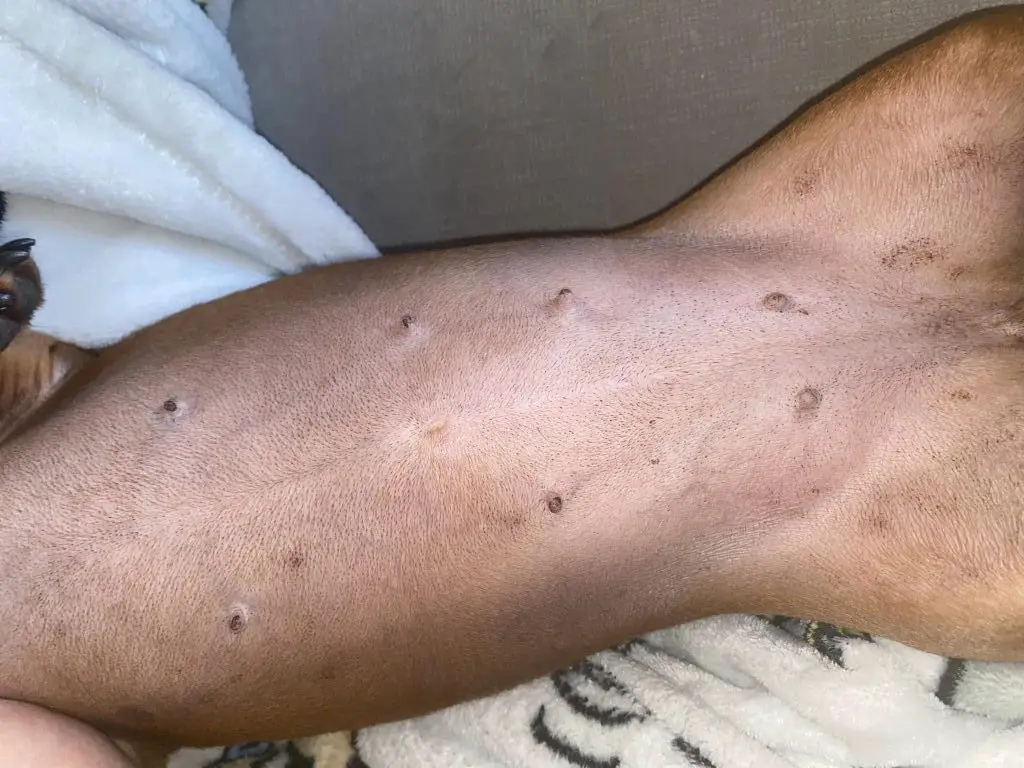
Allergies can cause a variety of skin problems in dogs, including brown spots. Allergic reactions usually cause itching and redness, but they can also lead to secondary bacterial or yeast infections, which can cause brown spots.
If your dog is scratching a lot or seems to be in discomfort, it is important to have them seen by a veterinarian so that the cause of the problem can be determined and appropriate treatment can be initiated.
Allergies are not dangerous for dogs. However, they can cause your dog to scratch and bite its skin, which can lead to secondary infections.
You should also try to avoid exposing them to whatever it is that they’re allergic to. If you can’t figure out what’s causing the allergy, then you may need to consult with a vet says Wag Walking.
Diagnosing Allergic Reactions in Dogs
- Observation of Symptoms: Symptoms can include skin irritation (redness, bumps, rashes), excessive scratching, sneezing, vomiting, diarrhea, swelling of the face, ears, lips, eyelids, or earflaps, and in severe cases, difficulty breathing.
- Medical History and Physical Examination: The vet will review the dog’s medical history and conduct a thorough physical examination to help determine the cause of the allergic reaction.
- Allergy Testing: Skin tests or blood tests can help identify what your dog is allergic to.
- Elimination Diet: If a food allergy is suspected, the vet may recommend an elimination diet to pinpoint the specific food causing the reaction.
Treating Allergic Reactions in Dogs
- Removal of the Allergen: The most effective treatment is to identify and remove the allergen from the dog’s environment.
- Medication: Antihistamines, corticosteroids, or other medications may be prescribed by the vet to reduce symptoms.
- Topical Treatments: For skin allergies, medicated shampoos, creams, or sprays can help soothe irritation and reduce scratching.
- Immunotherapy: If the allergen can’t be avoided, immunotherapy (allergy shots) can help desensitize the dog to the allergen.
- Dietary Changes: If the allergic reaction is caused by a particular food, the vet will recommend a diet change.
7. Sun exposure
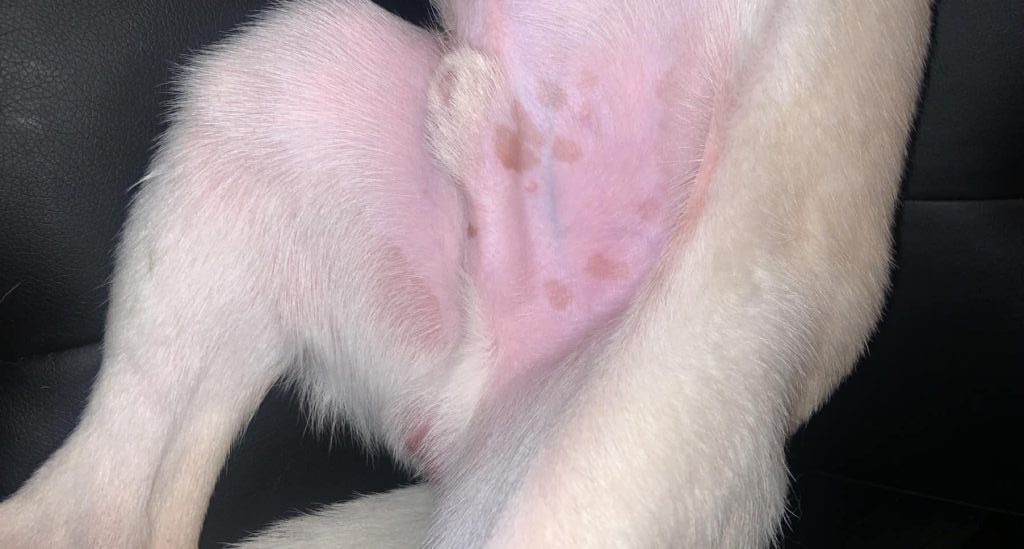
Sun exposure can cause brown spots on a dog’s skin. The ultraviolet rays in sunlight can damage the DNA in a dog’s skin cells, causing them to mutate. These mutated cells produce more melanin, which gives the skin a brownish tint.
Brown spots on a dog’s skin are usually benign, but they can be a sign of skin cancer if they change shape or size.
Diagnosing Sun Exposure in Dogs
- Visual Inspection: Sunburn in dogs appears as redness or flaky skin that may be tender to the touch. It usually occurs on areas with little to no fur, such as the belly and inside of the legs.
- Observation of Symptoms: Symptoms of excessive sun exposure can include signs of discomfort like constant scratching, licking, or biting at the skin, changes in skin color, and in severe cases, blisters or sores.
- Veterinary Examination: If you suspect your dog has been overly exposed to the sun, a vet should examine them. The vet might perform skin tests or biopsies if there are any suspicious lesions that could indicate skin cancer.
Treating Sun Exposure in Dogs
- Immediate Relief: If your dog has a mild sunburn, applying a cool compress to the affected area can help soothe the skin.
- Topical Treatments: Aloe vera or other pet-safe creams or lotions can help to soothe sunburned skin. Always consult with your vet before applying any products to ensure they’re safe for your dog.
- Hydration and Rest: Ensure your dog is well-hydrated and allow them to rest in a cool, shaded area.
- Prevention: Preventing sun exposure is key. Limit your dog’s exposure to the sun, especially during peak hours. Use pet-friendly sunscreen, provide shade, or consider protective clothing for dogs prone to sunburn.
- Regular Check-ups: Regular veterinary check-ups can help detect any potential issues caused by sun exposure early.
- Surgery or Medication: In severe cases where skin cancer has developed, surgery, chemotherapy, or radiation may be necessary. In fact, 36.6% of dogs affected by sun exposure require surgery according to Radiation Research.
8. Natural freckles or dapples on dogs
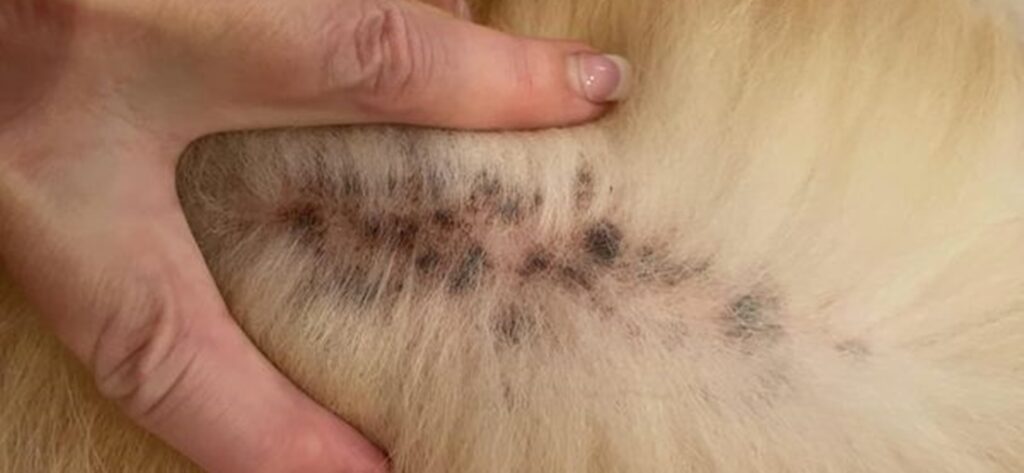
Natural freckles or dapples on dogs are benign skin pigmentation variations that can appear as brown spots on the belly, resembling dirt.
When you notice brown spots on your dog’s belly, it’s possible that these are simply natural freckles or dapples. These spots are a result of increased melanin production in those specific skin areas, which leads to the characteristic brown color.
This phenomenon is quite common in certain dog breeds and can often create a pattern that might look like dirt specks at first glance.
In my experience as a vet, I’ve encountered numerous cases where concerned pet owners mistook these harmless pigment spots for dirt or a potential health issue.
Diagnosing Natural Freckles or Dapples in Dogs
- Visual Inspection: Freckles or dapples appear as small, round, brownish spots on the skin or fur. They can be anywhere on the body but are commonly found on the belly or legs.
- Breed Predisposition: Certain breeds like Dalmatians, Basset Hounds, and English Setters are known for their dappled coats.
- Consistency Over Time: Unlike health-related skin conditions, freckles or dapples tend to remain consistent over time. They don’t grow, change shape, or cause discomfort to the dog.
- Veterinary Examination: If you notice any changes in your dog’s freckles or dapples, such as an increase in size, changes in color, or if they become raised, it’s best to have your vet examine them to rule out any health issues.
Treating Natural Freckles or Dapples in Dogs
- Regular Check-ups: Regularly check your dog’s skin, especially if they have a lot of freckles or dapples. Look for any changes in size, shape, or color.
- Sun Protection: Dogs with light-colored fur or lots of freckles may be more susceptible to sunburn. Limit sun exposure and consider using a pet-safe sunscreen.
- Veterinary Care: If you observe any changes in your dog’s freckles or dapples, consult your vet. In rare cases, skin cancer can appear similar to freckles.
9. Hyperpigmentation
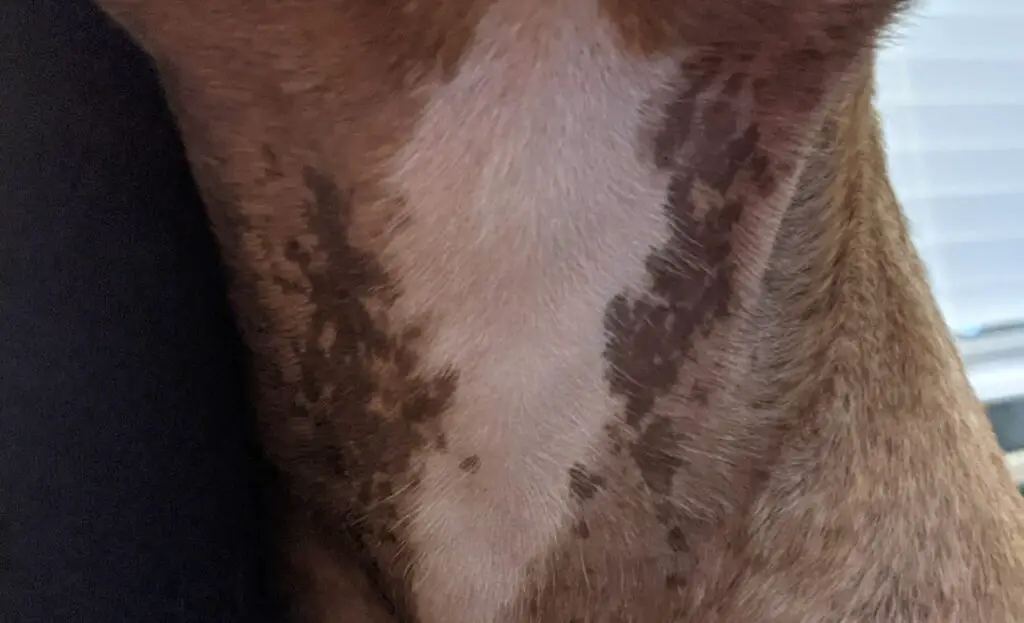
Hyperpigmentation can cause brown spots on a dog’s belly that look like dirt, as it leads to the darkening and thickening of the skin in certain areas.
When we talk about hyperpigmentation, we are referring to a condition where a dog’s skin begins to darken and thicken, often appearing as brown spots that resemble dirt.
This usually happens in areas where the skin is exposed, such as the belly, legs, and groin. The color change is due to an increase in melanin, the pigment that determines skin color.
In my years of veterinary practice, I’ve seen many cases of hyperpigmentation in dogs. It’s typically a secondary condition, meaning it’s a symptom or consequence of another underlying issue, such as inflammation, allergies, hormonal imbalances, or specific diseases like hypothyroidism or Cushing’s disease says The Canadian Veterinary Journal.
Diagnosing Hyperpigmentation in Dogs
- Visual Inspection: Hyperpigmentation appears as patches of skin that are darker than the surrounding skin. These patches can be black, brown, or gray.
- Medical History and Physical Examination: The vet will review the dog’s medical history and conduct a thorough physical examination to help identify any underlying conditions causing the hyperpigmentation.
- Diagnostic Tests: These may include blood tests, skin scrapings, biopsies, or allergy tests to determine the cause of the hyperpigmentation.
Treating Hyperpigmentation in Dogs
- Addressing Underlying Conditions: Conditions such as allergies, dermatitis, obesity, hormonal imbalances, or endocrine diseases can cause hyperpigmentation. Treating these conditions often resolves the hyperpigmentation.
- Topical Treatments: For skin irritations causing hyperpigmentation, medicated shampoos or creams can help soothe the skin and reduce discoloration.
- Dietary Changes: A balanced diet rich in omega-3 fatty acids can promote healthy skin and coat.
- Medication: If hyperpigmentation is due to a hormonal imbalance, medication may be required.
- Surgery: In rare cases, if the hyperpigmentation is due to a tumor, surgical removal might be necessary.
10. Parasites

Parasites, especially fleas, can cause brown spots on a dog’s belly that look like dirt due to their droppings, commonly referred to as “flea dirt”.
When discussing parasites as a cause for brown spots on your dog’s belly, the most common culprits are fleas. These tiny insects live on the skin of dogs and feed on their blood.
As they digest this blood meal, they excrete it as small, dark droppings known as “flea dirt”. This can appear as tiny brown or black spots scattered across your dog’s belly, which may be mistaken for dirt.
In my years of veterinary practice, I’ve encountered many dogs with flea infestations. The presence of these brown spots, along with other symptoms such as itching, redness, and inflammation, often points towards a flea problem.
Diagnosing Parasites in Dogs
- Visual Inspection: Fleas, ticks, and mites can often be seen on the dog’s skin or fur. Worms may be visible in the dog’s feces or vomit.
- Observation of Symptoms: Symptoms of a parasite infestation can include itching, hair loss, weight loss, changes in appetite, diarrhea, and fatigue.
- Veterinary Examination: A vet can perform tests such as fecal examinations, blood tests, or skin scrapings to confirm a parasite infestation.
Treating Parasites in Dogs
- Medication: Vets usually prescribe medication to kill parasites. This could be oral medication, topical treatments, or injections.
- Preventative Measures: Regular use of preventative treatments can keep parasites at bay. These include flea and tick preventatives and heartworm medication.
- Environmental Cleaning: Cleaning the dog’s environment, including bedding and yard, can help eliminate parasites and prevent re-infestation.
- Hygiene: Regular grooming and bathing can help remove parasites and maintain the dog’s overall skin health as per PDSA.
11. Medications
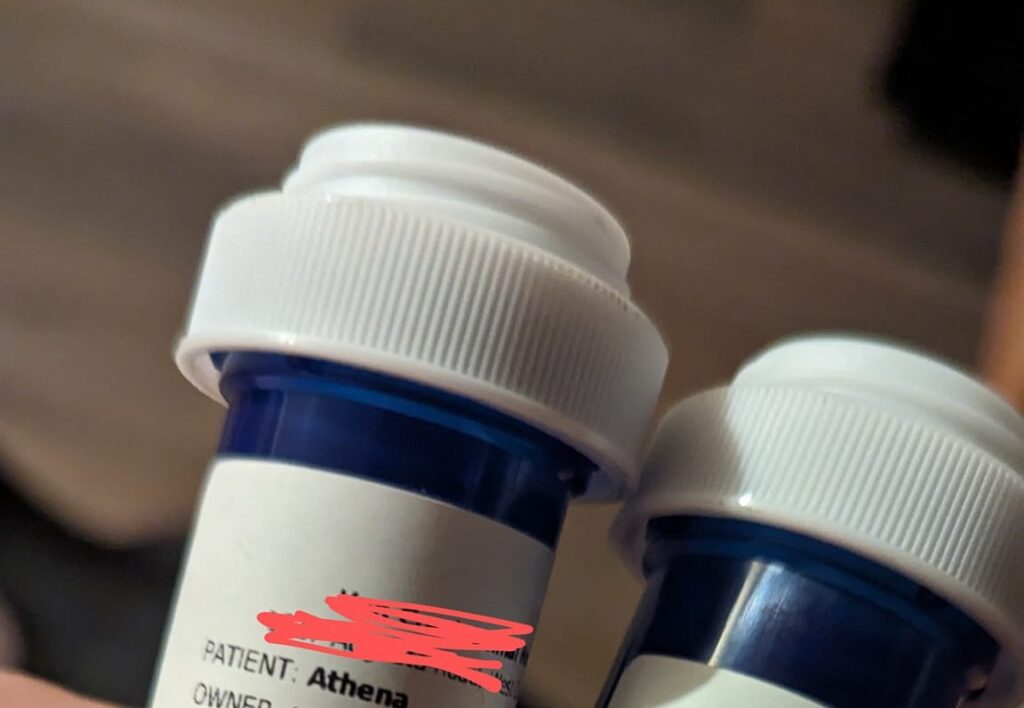
Medications can sometimes cause brown spots on a dog’s belly that look like dirt, as certain drugs can lead to changes in skin pigmentation.
In the context of medications causing brown spots on your dog’s belly, it’s worth noting that some drugs can lead to alterations in skin color.
These changes can manifest as brown spots or patches that may resemble dirt at first glance. The spots are usually a result of hyperpigmentation, a condition where the skin produces excess melanin, the pigment responsible for skin color.
From my years of experience in veterinary practice, I’ve noticed that drugs such as hormones, steroids, and certain antibiotics can sometimes lead to hyperpigmentation in dogs.
These medications can interfere with the body’s normal processes, leading to an overproduction of melanin in certain areas of the skin.
It’s crucial to keep in mind that these spots are typically harmless and do not cause discomfort or irritation to the dog. However, they are a visible sign of a change in your dog’s body, potentially due to medication. If you notice these spots after starting a new medication, it’s a good idea to consult with your vet.
12. Underlying hormonal or immune conditions

Underlying hormonal or immune conditions can result in brown spots on a dog’s belly that look like dirt, as these conditions may lead to skin changes like hyperpigmentation.
When discussing underlying hormonal or immune conditions in relation to brown spots on your dog’s belly, it’s important to understand that these internal imbalances can trigger skin changes.
These changes often manifest as hyperpigmentation, a skin condition characterized by the darkening of the skin due to an increase in melanin production. This can appear as brown spots or patches that may be mistaken for dirt.
In my veterinary practice, I’ve seen cases where hormonal imbalances, such as hypothyroidism or Cushing’s disease, have led to hyperpigmentation in dogs. Similarly, certain immune conditions, like autoimmune skin diseases, can also contribute to this symptom.
Diagnosing Underlying Hormonal or Immune Conditions in Dogs
- Observation of Symptoms: Symptoms may include changes in appetite, weight gain or loss, excessive thirst or urination, lethargy, hair loss, and skin changes like brown spots.
- Veterinary Examination: A vet will conduct a thorough physical examination and review the dog’s medical history.
- Diagnostic Tests: These may include blood tests, urine tests, skin biopsies, and endocrine function tests to identify hormonal imbalances or immune disorders.
Treating Underlying Hormonal or Immune Conditions in Dogs
- Hormone Therapy: Conditions like hypothyroidism or Cushing’s disease may require hormone therapy to restore balance.
- Immunosuppressive Drugs: If the brown spots are due to an overactive immune system, drugs that suppress the immune response may be necessary.
- Dietary Changes: Certain dietary changes might be recommended to support the dog’s overall health and immune system.
- Topical Treatments: Medicated shampoos or creams can help soothe the skin and reduce brown spots.
- Regular Monitoring: Regular follow-ups with the vet are crucial to monitor the dog’s response to treatment and adjust as necessary.
13. Vitiligo
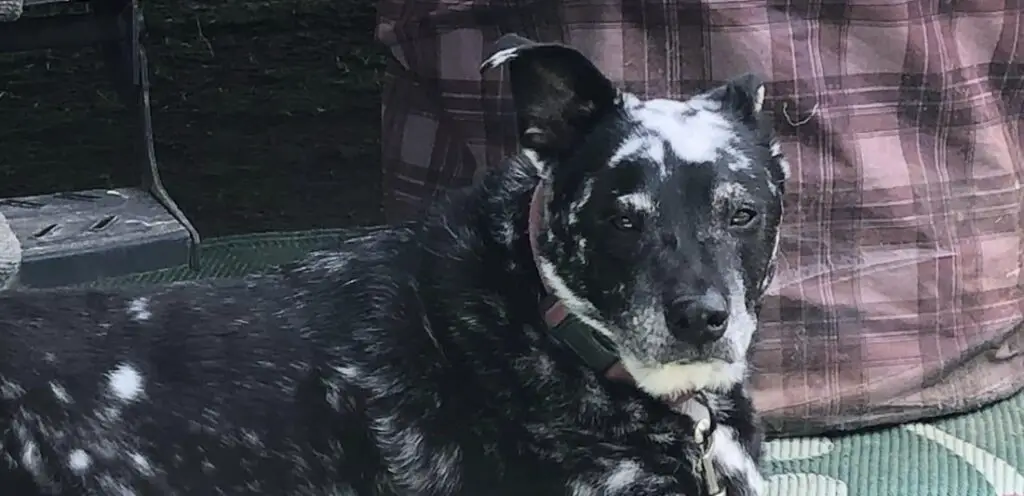
Vitiligo, a condition causing loss of pigment in the skin, can result in brown spots on a dog’s belly that look like dirt, as it leads to patches of fading color or white.
When discussing vitiligo as a potential cause for brown spots on your dog’s belly, it’s crucial to clarify that this condition involves the loss of skin pigment. This depigmentation process can lead to areas of fading color or even white patches, which may be mistaken for dirt or other blemishes.
In my experience as a veterinarian, I’ve seen dogs with vitiligo present with a variety of symptoms, including brown spots or patches on their belly. These spots are typically more noticeable on darker-skinned dogs, as the contrast between the dark skin and the light spots is more stark.
Diagnosing Vitiligo in Dogs
- Visual Inspection: Vitiligo typically presents as symmetrical white or light patches on the dog’s skin, fur, or both. Brown spots could also be present.
- Veterinary Examination: A vet will conduct a thorough physical examination and review the dog’s medical history.
- Diagnostic Tests: Skin biopsies, blood tests, and possibly autoantibody tests may be performed to confirm vitiligo and rule out other conditions says PetMD.
Treating Vitiligo in Dogs
- Cosmetic Solutions: As vitiligo is generally not harmful to the dog’s health, some owners choose to use pet-safe dyes to cover the discolored patches.
- Sun Protection: Dogs with vitiligo may be more susceptible to sunburn, so using pet-safe sunscreens or protective clothing may be necessary.
- Immunomodulatory Drugs: In some cases, drugs that modify the immune response may be used, but this is not typically the first line of treatment due to potential side effects.
- Regular Check-ups: Regular veterinary check-ups are crucial to monitor the progression of the condition and adjust the treatment plan as necessary.
When Brown Spots On a Dog’s Belly Are Not a Concern
Brown spots on a dog’s belly often aren’t a cause for concern as they can be due to numerous benign factors such as aging, sun exposure, or simply a part of the dog’s natural skin pigmentation.
While examining dogs in my practice, I’ve noticed that many of these brown spots are simply hyperpigmentation – a common condition where parts of the dog’s skin darken due to an increase in melanin.
The spots usually appear on the belly, legs, and groin areas. They’re typically harmless and don’t cause any discomfort to the dog.
Sometimes, these spots may also be age spots. Much like humans, dogs too can develop these darker, discolored areas on their skin as they grow older.
These are usually found on the belly, ears, and nose and are caused by a buildup of excess melanin. This is a natural part of the aging process and isn’t something to worry about.
However, it’s important to keep an eye on these spots. If you notice any changes in size, shape, or color, or if they appear to be causing your furry friend any discomfort, it’s worth having them checked out, as they could indicate more serious issues such as skin infections or even cancer.
In my professional experience, most brown spots on a dog’s belly are not a cause for alarm. But as a responsible pet owner, always stay vigilant for any significant changes and don’t hesitate to seek veterinary advice when in doubt.
When Brown Spots On a Dog’s Belly Are a Cause For Concern
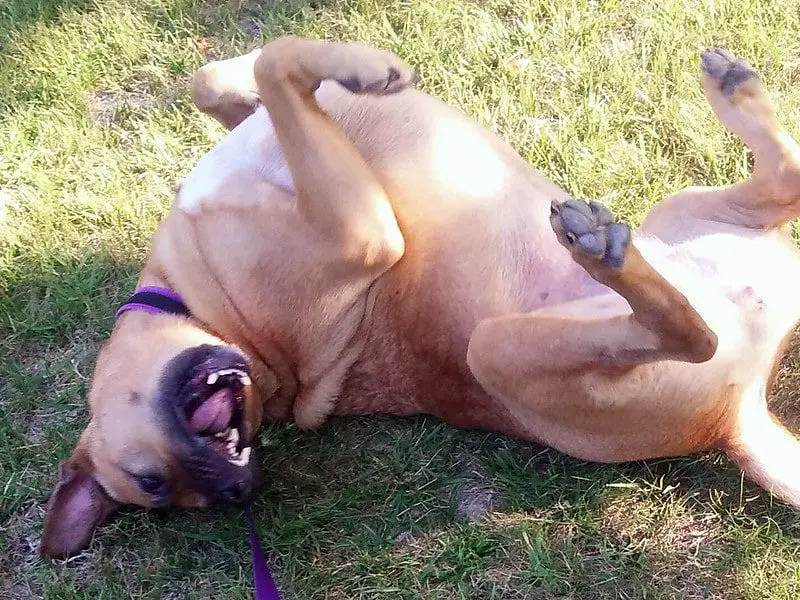
Brown spots on a dog’s belly become a cause for concern when they are associated with symptoms such as hair loss or discomfort or are linked to whole-body health conditions like hypothyroidism, Cushing’s disease, and diabetes.
While it’s common for dogs to develop brown spots on their belly due to benign reasons like aging or sun exposure, there are instances where these spots can indicate a more serious health issue.
Some of these conditions include hypothyroidism, Cushing’s disease, and diabetes, which can all result in dark or brown spots on the skin. These spots can be accompanied by other symptoms such as hair loss, increased thirst, and changes in appetite or behavior.
Another cause of brown spots on a dog’s belly that warrants veterinary attention is a yeast infection. This type of infection can result in brown spots along with symptoms like itching, redness, and a musty odor.
Similarly, if these spots are due to fleas, you may notice flea dirt, which looks like tiny black specks, along with the brown spots.
In my years of practice, I have also seen cases where brown spots were an early sign of melanoma, a type of skin cancer. In such cases, the spots may change in size, shape, or color, and the dog might appear uncomfortable or try to scratch or lick the area frequently.
How To Diagnose Brown Spots On Dog’s Belly

Brown spots on a dog’s belly are diagnosed through a series of examinations and tests carried out by a professional veterinarian, which may include a visual examination, skin scraping test, fungal culture, allergy testing, and biopsy.
Visual Examination
As a vet, I begin the diagnostic process with a visual examination. This helps me to assess the general condition of your dog’s skin, identify the location and appearance of the brown spots, and look for any accompanying symptoms such as redness, swelling, or hair loss.
Skin Scraping Test
A skin scraping test is often used to diagnose conditions such as mites or parasites that could be causing the brown spots. In this test, I scrape off a small sample of your dog’s skin and examine it under a microscope.
Fungal Culture
If I suspect a yeast or fungal infection, I may conduct a fungal culture. This involves collecting a sample from the affected area and sending it to a lab, where it’s tested for the presence of fungi.
Allergy Testing
Allergy testing can help determine if the brown spots are caused by an allergic reaction. This might involve a blood test or a skin test, where small amounts of potential allergens are introduced to your dog’s skin to see if they cause a reaction says Dr. Linda S. MVB MRCVS, Veterinarian.
Biopsy
In cases where the cause of the brown spots is still unclear, or if I suspect a serious condition like melanoma, I may recommend a biopsy. This involves removing a small piece of the affected skin for further analysis.
How To Treat Brown Spots On Dog’s Belly

The treatment for brown spots on a dog’s belly depends on the underlying cause and can range from topical treatments and medicated shampoos to dietary changes, allergy medications, or in severe cases, surgical intervention.
Topical Treatments and Medicated Shampoos
If the brown spots on your dog’s belly are caused by a skin infection or overproduction of sebum, I often recommend using an antiseborrheic shampoo or other topical treatments. These products can help control the infection and reduce inflammation, providing relief for your pet.
Dietary Changes
In some cases, especially when allergies are involved, I have found that making certain dietary changes can help treat brown spots on a dog’s belly. This might involve switching to a hypoallergenic diet or eliminating certain foods that could be causing an allergic reaction.
Allergy Medications
If the brown spots are due to an allergic reaction, I may prescribe allergy medications to help manage the symptoms. These can include antihistamines or corticosteroids, which can help reduce inflammation and itching.
Surgical Intervention
In more serious cases, such as when the brown spots are caused by melanomas or other types of skin cancers, surgical intervention may be necessary. As a vet, I always discuss all the options with the pet owner before deciding on the best course of action.
Monitoring and Regular Check-ups
Regardless of the cause or treatment plan, regular check-ups are important to monitor the condition and make sure the treatment is working. If the brown spots persist or worsen, further diagnostic tests may be needed.
Can New Brown Spots on a Dog’s Skin Be a Sign of Cancer?
New brown spots on a dog’s skin can potentially be a sign of cancer, but it is important to remember that not all brown spots are cancerous.
Some types of skin cancer, such as melanoma or mast cell tumors, may appear as pigmented spots or lumps on the skin. These spots may change in size, shape, or color over time, and may also become raised, ulcerated, or bleed.
If you notice any new brown spots or changes in existing spots on your dog’s skin, it is essential to consult with a veterinarian for a proper evaluation. The vet will perform a physical examination and may recommend additional diagnostic tests, such as a biopsy or fine needle aspiration, to determine if the spots are cancerous or benign.
What Is Hyperpigmentation?

Hyperpigmentation in dogs is a condition where the skin becomes darker than usual due to an increase in melanin production.
Melanin is the pigment responsible for the color of the skin, hair, and eyes. In hyperpigmentation, excess melanin accumulates in the skin, leading to the appearance of darkened patches or spots.
Several factors can cause hyperpigmentation in dogs, including:
- Inflammation: Skin inflammation from allergies, infections, or other irritants can lead to increased melanin production as part of the healing process, resulting in hyperpigmentation.
- Friction: Constant friction or pressure on specific areas of the skin, such as from a collar, harness, or even licking and scratching, can stimulate melanin production and cause hyperpigmentation.
- Hormonal imbalances: Conditions like hypothyroidism or Cushing’s disease can affect the hormones that regulate melanin production, causing changes in skin pigmentation.
- Genetics: Some dog breeds are more prone to hyperpigmentation due to their genetic predisposition.
- Underlying health conditions: Certain diseases or disorders, such as acanthosis nigricans or seborrheic dermatitis, can cause hyperpigmentation as a secondary symptom.
Can A Dog Get Age Spots?
Yes, dogs can develop age spots, also known as lentigines or liver spots. Age spots are harmless, flat, pigmented areas that typically appear on the skin as a dog gets older.
These spots are usually brown or black and can vary in size and shape. They are more common in dogs with lighter skin and fur and can appear anywhere on the body, including the belly, limbs, and muzzle.
Age spots in dogs are caused by an increase in melanin production within the skin cells, which leads to the formation of pigmented patches.
These spots are generally benign and do not cause any discomfort or irritation to the dog. However, it is essential to monitor any changes in the appearance of age spots, such as rapid growth, irregular borders, or ulceration, as these could indicate a more serious issue, like skin cancer.
How To Prevent Brown Spots on Dog’s Belly From Appearing
Preventing brown spots from appearing on a dog’s belly involves consistent hygiene practices, maintaining a healthy diet, regular vet check-ups, and protecting the dog from excessive sun exposure.
Maintain Hygiene
Maintaining proper hygiene is crucial to prevent conditions like yeast infections that can cause brown spots on your dog’s skin. Regular baths with quality dog shampoos can help keep their skin clean and healthy. In my practice, I’ve often seen how effective a simple routine of regular baths can be in preventing skin issues in dogs.
Provide a Balanced Diet
A balanced diet is key to ensuring your dog’s overall health, including skin health. Foods rich in Omega-3 fatty acids can promote healthy skin and coat. As a vet, I’ve often recommended Omega-3 supplements or foods like fish and flaxseed to improve a dog’s skin condition.
Regular Vet Check-ups
Regular vet check-ups can help identify any potential issues early, including those that may lead to brown spots on the skin. Vets can provide advice on preventive measures based on your dog’s specific needs. In my years as a vet, I’ve seen how early detection can significantly improve a dog’s prognosis with various health issues.
Protect from Sun Exposure
Excessive sun exposure can cause hyperpigmentation and lead to brown spots on your dog’s skin. Providing shade during outdoor activities and using pet-safe sunscreens can help protect your dog’s skin. I once treated a dog with significant sun-induced hyperpigmentation, and with a few changes to its outdoor routine, we saw a noticeable improvement.
FAQs
Q: What are those brown spots on my dog’s belly that look like dirt?
A: Those brown spots are most likely signs of hyperpigmentation, which is a darkening of the skin due to an overproduction of melanin. It can also be caused by a skin infection, such as a yeast infection.
Q: Can hyperpigmentation in dogs be a sign of a more serious condition?
A: In some cases, yes. Secondary hyperpigmentation can be a sign of an underlying issue such as an autoimmune disease, endocrine disorder, or skin cancer. If you notice any other symptoms like hair loss or skin changes, it’s best to see a vet.
Q: What causes brown spots on a dog’s belly?
A: Brown spots on a dog’s belly can be caused by a variety of things, including age spots, flea dirt, or a bacterial or yeast infection. Your dog’s breed and genetics can also play a role.
Q: Can flea bites cause brown spots on a dog’s belly?
A: Yes, flea bites can cause brown spots on a dog’s belly. Fleas leave behind the fecal matter, which appears as small brown dots on a dog’s skin. If left untreated, this can lead to a rash and even further infection.
Q: Are age spots common in dogs?
A: Yes, age spots are common in dogs as they age. These are usually harmless and may appear as small, round, dark spots on the skin.
Q: How can I tell the difference between brown spots on my dog’s skin and dirt?
A: Brown spots on a dog’s skin may have a slightly different texture than dirt and will not easily wipe away with a damp cloth. If you’re unsure, it’s best to see a vet for a proper diagnosis.
Q: Can yeast infections cause brown spots on a dog’s belly?
A: Yes, chronic yeast infections can cause dark spots on a dog’s skin. These infections are often accompanied by other symptoms like itching, rashes, and a foul odor.
Q: What should I do if I notice dark spots on my dog’s belly?
A: If you notice dark spots on your dog’s belly, it’s best to take them to a vet for an examination. The vet can provide a proper diagnosis and recommend treatment if necessary.
Q: Can skin cancers cause brown spots on a dog’s belly?
A: Yes, skin cancers can cause brown spots on a dog’s skin. If you notice any unusual growths or changes in your dog’s skin, it’s important to see a vet as soon as possible.
Q: How can I prevent brown spots on my dog’s belly?
A: While some causes of brown spots are out of your control, there are things you can do to help prevent them. Keeping your dog clean and well-groomed can help prevent flea infestations and skin infections. You can also feed your dog a healthy diet and give them regular exercise to support their overall health.
Conclusion and final thoughts
Brown spots on a dog’s belly that look like dirt could be a cause for concern or simply a harmless skin condition.
These spots may result from various factors, such as allergies, skin infections, parasites, or hyperpigmentation.
It’s essential to closely monitor your dog’s skin and overall health, paying attention to any changes in the appearance or texture of the spots, as well as any accompanying symptoms.
To ensure your dog’s well-being and receive an accurate diagnosis, consult with a veterinarian who can recommend appropriate treatment or management options if needed.
Remember, a healthy dog is a happy dog, and addressing any skin issues promptly can contribute to their overall quality of life.




